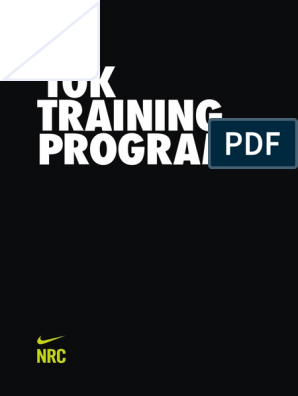50% found this document useful (2 votes)
4K views25 pagesNike Run Club 5K Training Plan
This document provides an 8-week training program to prepare a runner to complete a 5K race. The program includes speed runs to build strength, long runs to develop endurance, and recovery runs for rest. It recommends recording runs with an app to track progress and get encouragement. The plan is flexible to suit individual schedules and abilities. It includes a pace chart to identify target paces for different types of runs based on past race performances. The goal is to maximize fitness and prepare both physically and mentally for the challenges of racing a 5K.
Uploaded by
SalvadorCopyright
© © All Rights Reserved
We take content rights seriously. If you suspect this is your content, claim it here.
Available Formats
Download as PDF, TXT or read online on Scribd
50% found this document useful (2 votes)
4K views25 pagesNike Run Club 5K Training Plan
This document provides an 8-week training program to prepare a runner to complete a 5K race. The program includes speed runs to build strength, long runs to develop endurance, and recovery runs for rest. It recommends recording runs with an app to track progress and get encouragement. The plan is flexible to suit individual schedules and abilities. It includes a pace chart to identify target paces for different types of runs based on past race performances. The goal is to maximize fitness and prepare both physically and mentally for the challenges of racing a 5K.
Uploaded by
SalvadorCopyright
© © All Rights Reserved
We take content rights seriously. If you suspect this is your content, claim it here.
Available Formats
Download as PDF, TXT or read online on Scribd
/ 25

























































































